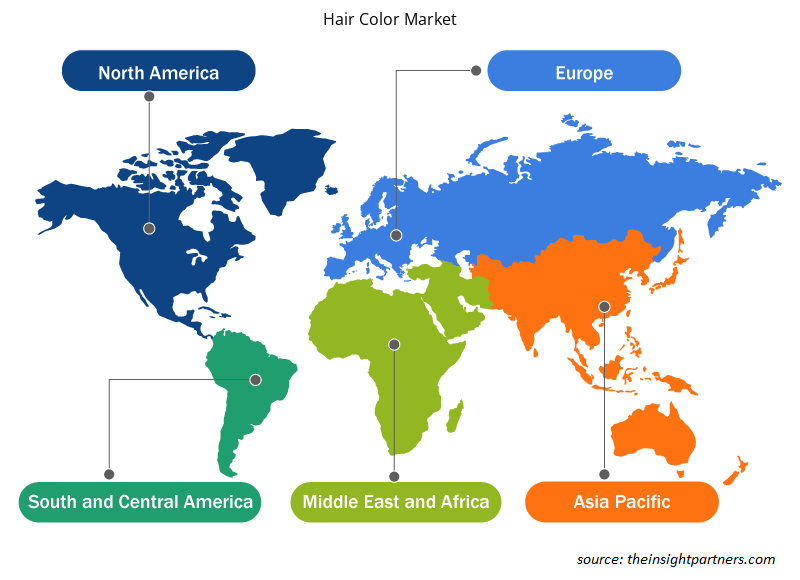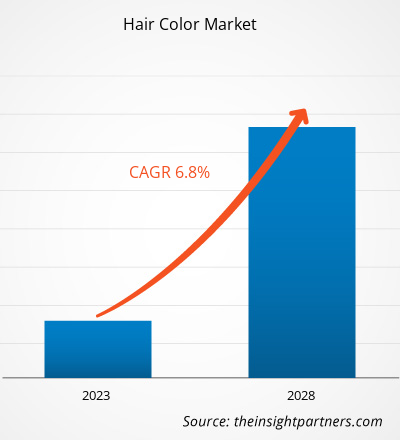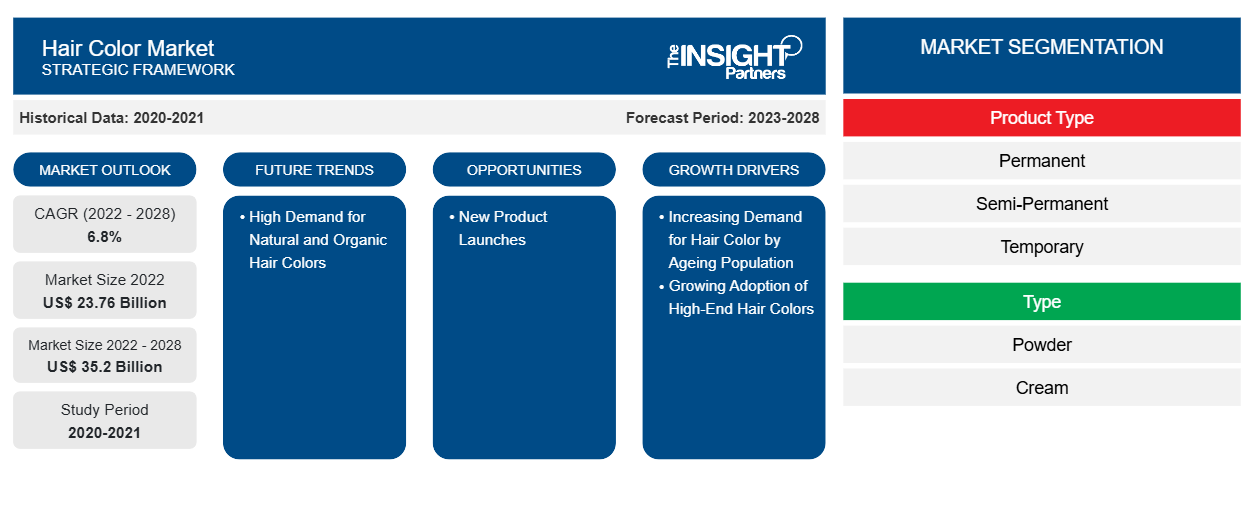[Rapport de recherche] Le marché de la coloration capillaire devrait passer de 23 762,28 millions USD en 2022 à 35 201,69 millions USD en 2028 ; il devrait croître à un TCAC de 6,8 % de 2022 à 2028.CAGR of 6.8% from 2022 to 2028.
Le rapport met en évidence les facteurs clés qui animent le marché et les principaux acteurs ainsi que leurs évolutions sur le marché.
Informations sur le marché et point de vue des analystes :
Les colorations capillaires sont des teintures capillaires qui sont appliquées soit pour couvrir les cheveux gris, soit pour changer la couleur naturelle des cheveux. Il existe fondamentalement 3 types de colorations capillaires : permanentes, semi-permanentes et temporaires. Les colorations capillaires permanentes modifient de manière permanente la couleur naturelle des cheveux et donnent généralement les meilleurs résultats. Les colorations capillaires sont disponibles dans différentes nuances de couleurs telles que le noir, le marron et le bordeaux. Les consommateurs sont très soucieux de leur apparence, ce qui crée une demande importante de produits de soins personnels. Ce facteur stimule le marché de la coloration capillaire . De plus, le vieillissement de la population est également l'un des principaux facteurs qui stimulent la demande de colorations et de teintures capillaires.grey hair or for changing the natural color of hair. There are basically 3 types of hair colors: permanent, semi-permanent, and temporary. Permanent hair colors permanently change the natural hair color and usually give the best results. Hair colors are available in various color shades such as black, brown, and burgundy. Consumers are highly concerned about their appearance which is creating significant demand for personal grooming products. This factor is driving the
Moteurs de croissance et défis :
La demande croissante de coloration capillaire de la part de la population vieillissante stimule la croissance du marché de la coloration capillaire. Selon le World Population Ageing Review de 2019, il y a plus de 703 millions de personnes âgées de 65 ans ou plus dans le monde. La population mondiale vieillit rapidement en raison de la baisse des taux de fécondité et de l'augmentation de la longévité ou de l'espérance de vie. La population vieillissante utilise largement la coloration capillaire pour couvrir ses cheveux gris. Ce facteur stimule considérablement la demande de coloration capillaire. De plus, en raison des changements de mode de vie et des carences nutritionnelles, le taux de grisonnement prématuré augmente. Les gens constatent un grisonnement précoce des cheveux en raison du stress quotidien, de mauvaises habitudes alimentaires, du tabagisme et de certaines conditions médicales. Ce facteur devrait également stimuler la demande de colorations capillaires, stimulant ainsi la croissance du marché de la coloration capillaire.Ageing Review of 2019, there are more than 703 million people aged 65 or over in the world. The world population is aging rapidly due to declining fertility rates and increasing longevity or life expectancy. The aging population is widely using hair color to cover their grey hair. This factor is significantly driving the demand for hair color. Further, due to lifestyle changes and nutritional deficiencies, there is a rising rate of premature greying. People are witnessing early greying of hair due to daily stress, poor dietary habits, smoking, and certain medical conditions. This factor is also expected to boost the demand for hair colors, driving the hair color market growth.
Personnalisez ce rapport en fonction de vos besoins
Vous bénéficierez d'une personnalisation gratuite de n'importe quel rapport, y compris de certaines parties de ce rapport, d'une analyse au niveau des pays, d'un pack de données Excel, ainsi que de superbes offres et réductions pour les start-ups et les universités.
-
Obtenez les principales tendances clés du marché de ce rapport.Cet échantillon GRATUIT comprendra une analyse de données, allant des tendances du marché aux estimations et prévisions.
Segmentation et portée du rapport :
Le « marché mondial de la coloration des cheveux » est segmenté en fonction du type de produit, du type, du canal de distribution et de la géographie.En fonction du type de produit, le marché de la coloration capillaire est segmenté en permanente, semi-permanente et temporaire.En fonction du type, le marché de la coloration capillaire est segmenté en poudre, crème et autres. En fonction des canaux de distribution, le marché de la coloration capillaire est segmenté en supermarchés et hypermarchés, magasins spécialisés, vente au détail en ligne et autres. Le marché de la coloration capillaire en fonction de la géographie est segmenté en Amérique du Nord (États-Unis, Canada et Mexique), Europe (Allemagne, France, Italie, Royaume-Uni, Russie et reste de l'Europe), Asie-Pacifique (Australie, Chine, Japon, Inde, Corée du Sud et reste de l'Asie-Pacifique), Moyen-Orient et Afrique (Afrique du Sud, Arabie saoudite, Émirats arabes unis et reste du Moyen-Orient et de l'Afrique) et Amérique du Sud et centrale (Brésil, Argentine et reste de l'Amérique du Sud et centrale).UAE, and Rest of Middle East & Africa), and South & Central America (Brazil, Argentina, and Rest of South & Central America)
Analyse segmentaire : Analysis:
En fonction des canaux de distribution, le marché de la coloration capillaire est segmenté en supermarchés et hypermarchés, magasins spécialisés, vente au détail en ligne et autres. Le segment des supermarchés et hypermarchés détient une part importante du marché de la coloration capillaire et le segment de la vente au détail en ligne devrait enregistrer une croissance significative au cours de la période de prévision. Les supermarchés et hypermarchés sont de grands établissements de vente au détail qui proposent une variété de produits de marques locales et haut de gamme à des prix abordables. De plus, ces magasins disposent d'un personnel qualifié qui aide à trouver des produits en fonction des besoins des clients. De plus, ces magasins disposent de sections distinctes de produits cosmétiques et de soins personnels qui aident les clients à faire leurs achats de manière pratique et sans tracas. Ces facteurs stimulent les ventes de produits de coloration capillaire dans les supermarchés et les hypermarchés.
En fonction du type, le marché de la coloration capillaire est segmenté en poudre, crème et autres. En 2022, le segment de la poudre détenait la plus grande part de marché. Un grand nombre de consommateurs préfèrent les colorations capillaires à base de crème en raison de leur facilité d'application. De plus, elles contiennent des ingrédients hydratants qui rendent les cheveux doux et leur ajoutent de la brillance. Ces facteurs stimulent considérablement la croissance du segment.
Analyse régionale :
Français Sur la base de la géographie, le marché de la coloration capillaire est divisé en cinq régions clés : l'Amérique du Nord, l'Europe, l'Asie-Pacifique, l'Amérique du Sud et centrale, et le Moyen-Orient et l'Afrique. Le marché mondial de la coloration capillaire était dominé par l'Asie-Pacifique, qui représentait 7 741,75 millions de dollars américains en 2022. L'Amérique du Nord est un deuxième contributeur majeur détenant plus de 26 % des parts du marché mondial. L'industrie cosmétique en Asie-Pacifique est en pleine croissance, avec une demande croissante de produits haut de gamme et une augmentation du nombre de femmes qui travaillent. De plus, le vieillissement de la population dans la région contribue davantage à la croissance du marché de la coloration capillaire. Selon l'Organisation mondiale de la santé (OMS), la Chine a l'une des populations vieillissantes qui connaissent la croissance la plus rapide au monde. La population de plus de 60 ans en Chine devrait atteindre 28 % d'ici 2040, en raison de l'espérance de vie plus longue et de la baisse des taux de fécondité. Par conséquent, la demande croissante de soins personnels associée au nombre croissant de femmes qui travaillent et au vieillissement de la population devrait stimuler la croissance du marché de la coloration capillaire en Asie-Pacifique.
Développements de l'industrie et opportunités futures :
Diverses initiatives prises par les principaux acteurs opérant sur le marché de la coloration capillaire sont énumérées ci-dessous :
- En 2022, The Arctic Fox a lancé une nouvelle coloration capillaire, Space Cowgirl, qui se compose de couleurs vives aux tons verts ou pêche. Ce nouveau produit peut être mélangé avec Aquamarine, Poseidon, Neon Moon, Frose ou Periwinkle, dans des proportions distinctes fournies par l'entreprise, pour obtenir différentes nuances de couleurs de cheveux.
- En 2022, PZ Cussons a annoncé l'acquisition de Childs Farm, la marque leader du marché britannique des soins personnels pour bébés et enfants, avec une part de marché de 15 % dans la catégorie. Les gammes de produits comprennent des produits pour le bain et la douche, des soins de la peau et des soins capillaires, et sont toutes ancrées dans une proposition naturelle et adaptées aux peaux sensibles.
- En 2022, L'Oréal SA a annoncé le lancement de Colorsonic, destiné aux consommateurs, et des technologies Coloright, destinées aux coiffeurs. L'entreprise a travaillé avec 400 clients pour développer les produits Colorsonic. Le produit contient une cartouche de couleur (40 couleurs), un mélangeur (combine la couleur et la développe pour le client) et un applicateur à peigne. De plus, la technologie Coloright vise à créer de la cohérence et à ajouter des informations sur les données dans le processus de coloration.
Aperçu régional du marché de la coloration des cheveux
Les tendances régionales et les facteurs influençant le marché de la coloration capillaire tout au long de la période de prévision ont été expliqués en détail par les analystes d’Insight Partners. Cette section traite également des segments et de la géographie du marché de la coloration capillaire en Amérique du Nord, en Europe, en Asie-Pacifique, au Moyen-Orient et en Afrique, ainsi qu’en Amérique du Sud et en Amérique centrale.

- Obtenez les données régionales spécifiques au marché de la coloration des cheveux
Portée du rapport sur le marché de la coloration des cheveux
| Attribut de rapport | Détails |
|---|---|
| Taille du marché en 2022 | 23,76 milliards de dollars américains |
| Taille du marché d'ici 2028 | 35,2 milliards de dollars américains |
| Taux de croissance annuel composé mondial (2022-2028) | 6,8% |
| Données historiques | 2020-2021 |
| Période de prévision | 2023-2028 |
| Segments couverts |
Par type de produit
|
| Régions et pays couverts |
Amérique du Nord
|
| Leaders du marché et profils d'entreprises clés |
|
Densité des acteurs du marché de la coloration capillaire : comprendre son impact sur la dynamique commerciale
Le marché de la coloration capillaire connaît une croissance rapide, tirée par la demande croissante des utilisateurs finaux en raison de facteurs tels que l'évolution des préférences des consommateurs, les avancées technologiques et une plus grande sensibilisation aux avantages du produit. À mesure que la demande augmente, les entreprises élargissent leurs offres, innovent pour répondre aux besoins des consommateurs et capitalisent sur les tendances émergentes, ce qui alimente davantage la croissance du marché.
La densité des acteurs du marché fait référence à la répartition des entreprises ou des sociétés opérant sur un marché ou un secteur particulier. Elle indique le nombre de concurrents (acteurs du marché) présents sur un marché donné par rapport à sa taille ou à sa valeur marchande totale.
Les principales entreprises opérant sur le marché de la coloration des cheveux sont :
- Renard arctique
- Coty Inc.
- Henkel AG & Co. KGaA
- Kao Singapour Pte Ltd.
- L
Avis de non-responsabilité : les sociétés répertoriées ci-dessus ne sont pas classées dans un ordre particulier.

- Obtenez un aperçu des principaux acteurs du marché de la coloration capillaire
Impact du Covid-19 :
La pandémie de COVID-19 a touché presque tous les secteurs d'activité dans divers pays. Les confinements, les restrictions de voyage et les fermetures d'entreprises en Amérique du Nord, en Europe, en Asie-Pacifique (APAC), en Amérique du Sud et centrale (SAM) et au Moyen-Orient et en Afrique (MEA) ont entravé la croissance de plusieurs secteurs, notamment celui des biens de consommation. La fermeture des unités de fabrication a perturbé les chaînes d'approvisionnement mondiales, les activités de fabrication, les calendriers de livraison et les ventes de produits essentiels et non essentiels. Plusieurs entreprises ont constaté des retards dans les livraisons de produits et une baisse des ventes de leurs produits en 2020. En raison de la récession économique induite par la pandémie, les consommateurs sont devenus plus prudents et sélectifs dans leurs décisions d'achat. Cependant, la pandémie a provoqué la fermeture temporaire des salons de beauté, ce qui a obligé de nombreux consommateurs à faire leur propre coloration capillaire à la maison. Cela a augmenté la demande de colorations capillaires dans le secteur résidentiel. De plus, comme les gens étaient obligés de rester chez eux, ils se sont livrés à diverses activités de bricolage qui ont eu un impact positif sur les ventes de colorations capillaires. Cependant, comme les supermarchés, les hypermarchés, les centres commerciaux et les magasins qui vendent des produits non essentiels sont restés fermés pendant la phase initiale de la pandémie, les gens se sont appuyés sur les canaux de vente au détail en ligne tels qu'Amazon.com, eBay et SnapDeal.
Fin 2021, de nombreux pays étaient entièrement vaccinés et les gouvernements ont annoncé un assouplissement de certaines réglementations, notamment des mesures de confinement et des interdictions de voyager. Divers magasins, dont des supermarchés, des grands magasins, des centres commerciaux et des magasins familiaux, ont été autorisés à rouvrir, ce qui a également augmenté les ventes de produits de coloration capillaire. Tous ces facteurs ont eu une influence positive sur la croissance du marché de la coloration capillaire.
Paysage concurrentiel et entreprises clés :
Certains des principaux acteurs opérant sur le marché mondial de la coloration des cheveux comprennentArctic Fox ; Coty Inc. ; Henkel AG and Co., KGAA ; et Kao Singapore Pte. Ltd. ; Revlon, Inc. ; Hygienic Research Institute Pvt. Ltd ; L'oréal SA ; Wella Operations US LLC ; Unilever PLC ; et PZ Cussons Beauty LLP ; entre autres. Ces entreprises sont très impliquées dans des activités de fusions et acquisitions pour étendre leur empreinte géographique et améliorer leur expertise. En outre, ces entreprises adoptent des stratégies marketing innovantes telles que le marketing numérique, le marketing sur les réseaux sociaux et des campagnes publicitaires innovantes pour améliorer leur image de marque dans l'esprit des consommateurs potentiels.
- Analyse historique (2 ans), année de base, prévision (7 ans) avec TCAC
- Analyse PEST et SWOT
- Taille du marché Valeur / Volume - Mondial, Régional, Pays
- Industrie et paysage concurrentiel
- Ensemble de données Excel
Rapports récents
Rapports connexes
Témoignages
Raison d'acheter
- Prise de décision éclairée
- Compréhension de la dynamique du marché
- Analyse concurrentielle
- Connaissances clients
- Prévisions de marché
- Atténuation des risques
- Planification stratégique
- Justification des investissements
- Identification des marchés émergents
- Amélioration des stratégies marketing
- Amélioration de l'efficacité opérationnelle
- Alignement sur les tendances réglementaires























 Obtenez un échantillon gratuit pour - Marché de la coloration capillaire
Obtenez un échantillon gratuit pour - Marché de la coloration capillaire